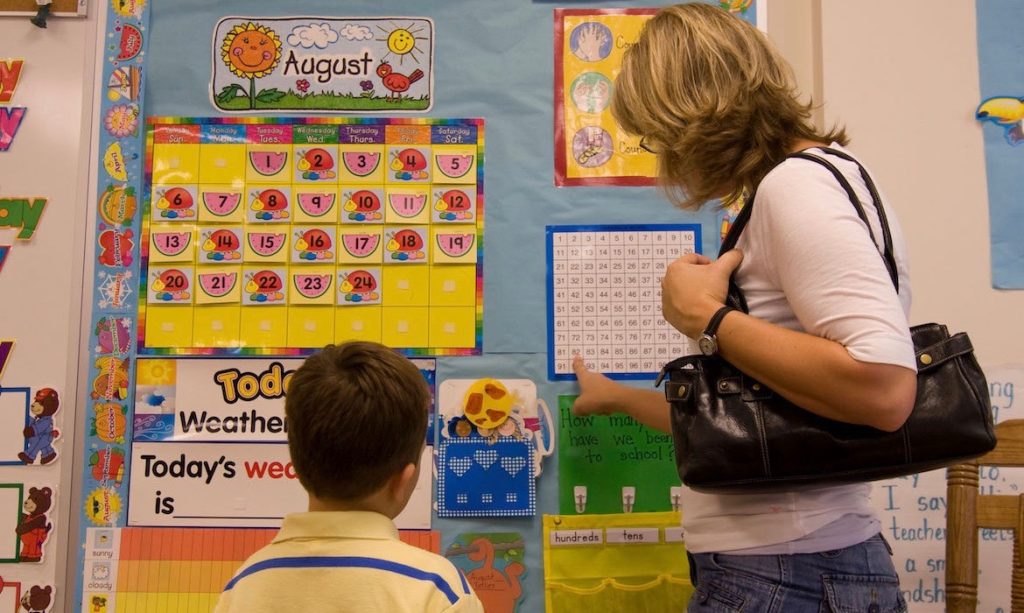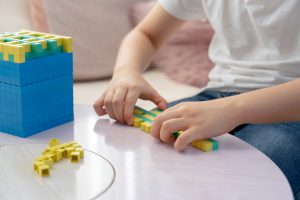- Small changes to classroom calendar activities can boost children’s early math learning.
- It’s best to keep calendar activities short. It’s also OK not to do calendar activities at all.
- Linear calendars can help young children learn about concepts such as time in a more natural way.
Many early childhood classrooms, especially preschool and kindergarten classrooms, feature a calendar as an activity to teach mathematics and sometimes other subjects (e.g., weather or days of the week). There are even entire early mathematics curricula based on calendars.
Why not? Calendars are a part of daily life. They mark important events. They help us understand our schedules. Well … for adults, anyway.
For children, it’s not clear if they understand the concepts of time in days, weeks, and months. A child says, “I’m gonna go to the park yesterday.” How can a calendar help explain the concept of yesterday? We’ll show you!
Challenges of Common Classroom Calendar Activities
You might be thinking: But calendars are numbers in order. Well, yes, and also in groups of seven. However, the important grouping in our number system is 10. A row of seven is not that helpful for young children to learn about our number system.
Class sessions on calendars can grow to consume quite a bit of time, up to 25 minutes in some classrooms. That is also usually during the best time of the day for meaningful learning—when children are fresh and ready to talk and think.
Furthermore, most of these sessions are designed to be done in whole group, with one student participating and others waiting. Take this common classroom scenario:
In one classroom, Mom picked up Quinten and noticed the calendar. “Hey, what day is it, Quinten?” “I don’t know,” Quinten replied. Mom responded, “But your class did calendar today.” Quinten agreed, “Yeah, but it was Aliyah’s turn today.”
Aliyah may have learned something because it was her turn to participate, but most of the rest of the class waited passively in the background. Research shows children learn mathematics by actively doing mathematics, not by listening, at best, or at worst, waiting.
Ideas for Boosting Early Math Learning Around Calendars
There are ways to increase the benefits of classroom calendar activities. You can try these better ideas, but if you do, keep the time short. Further, it’s OK not to do calendars at all!
One idea is to keep track of the number of days in the school year. Every day, the teacher writes the number on a piece of long tape along the wall and includes children in finding out the number. To figure out the number, try using the “Think-Pair-Share” strategy—where students work together to solve a problem—so everyone is involved. Keep the pace fast. Draw attention to the multiples of 10 by writing them in red or another color. To save time, count the days by 10s and then by ones.
Another way to support young children’s early math learning around calendars is to have the class figure out what number comes next. This activity uses a common classroom calendar that has an empty grid at the beginning of each month. There are pins in every day for hanging a laminated card with numbers to represent the days of the month. Every child takes a number card and hangs it in the correct place. To extend the learning, the odd numbers can be one shape, such as square cards, and the even numbers can be another shape, such as circles. Eventually, a pattern will emerge, and the teacher can lead a discussion about this key early math concept.
In addition to finding out what number comes next, classes can also figure out how many days until something happens. For example, specific days can have pictures marking holidays, birthdays of children in the class (even going ahead to summer for children with birthdays during those months), and any other special events. Classes can also keep a graph of the number of sunny, cloudy, rainy, and snowy days during the school year.
Linear Calendars Help Children Better Understand Time
Still, these activities use a traditional matrix calendar with numbers organized into groups of seven. Instead, a linear calendar can help young children learn about time in a more natural way. It can also lend itself to a lot of options for supporting early math learning. As early childhood educators, we’ve found this representation of the calendar much easier for young children (i.e., preschoolers) to learn. They just “get it.”
Here’s what a linear calendar can look like.

The days of the month are shown in a single horizontal line, with spaces above and below for pictures to convey more information. For example, in the top row, bookbags and houses can represent school and non-school days. The bottom row can show special events. A “no symbol”—a red circle with a red diagonal line through it—over the school icon can indicate that there is no school that day (e.g., a holiday).
Early Math Activities Based on Linear Calendars
The teacher can start by pointing to today’s date. Then point to yesterday and tomorrow’s dates. The days that come just before and just after a date seem to make much more sense when they’re presented in this linear way, like a number path.
The teacher can then go to the first day of the month and count out loud until reaching today’s date, saying the date again for good measure. The teacher can cross off each day (on the numeral) as it comes to an end.
To further practice children’s early math competencies, use the pictures representing special events to talk about how many days since or how many days until an event. For example, “Today is July 7. Conner’s birthday is on July 19. How many days is it until his birthday?” Then count up from the current date to the special date to get children exploring simple addition concepts.
If there’s space in the classroom, connect the calendars from each month in a line around the room, making one really long linear calendar. At the end of the school year, have a ceremonial calendar cutting where the linear calendar is cut into sections and reassembled as a standard matrix calendar. Children love it!
If we had to do it over again, we would start with the linear calendar to help our early learners better understand the concept of time. It would also offer opportunities to practice some important math skills in the process. After that, we would move on to the traditional matrix calendar.
What about you?



